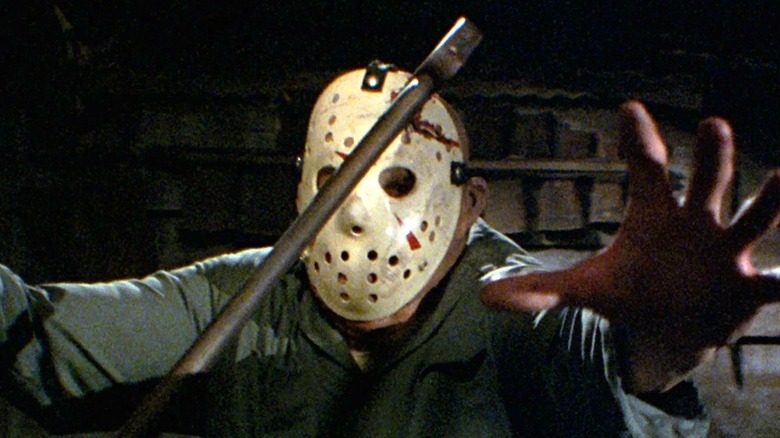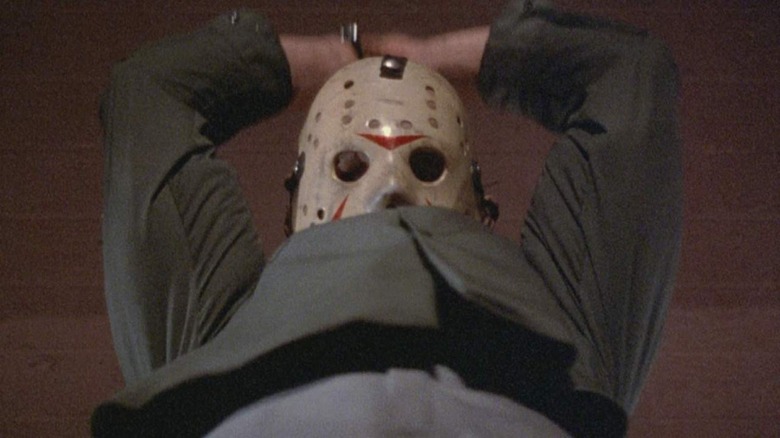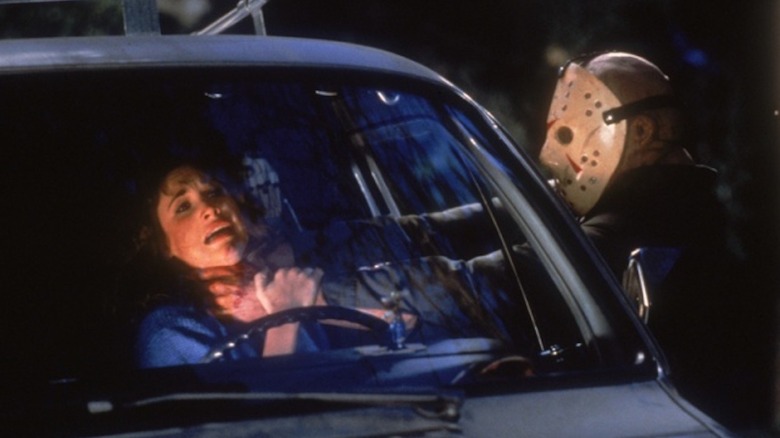The Friday The 13th Sequel That Kicked Off A Trend In Horror Movies
1982 was a watershed year in terms of theatrical exhibition. The hit-cluttered summer release schedule — which included all-timers like "E.T. the Extra-Terrestrial," "Poltergeist" and "An Officer and a Gentleman" — firmly established the season as a commercial goldmine. Tucked in between the blockbusters and bombs was the modest sensation of "Friday the 13th Part 3." Directed by steady studio hand Steve Miner, the second sequel in the Paramount franchise sought to spice up its slasher formula by shooting in native 3D.
The format gamble worked. "Friday the 13th Part 3" opened to a then massive $9.3 million over the August 13 weekend, outgrossing "E.T." and compelling studios to consider wringing a few extra drops out of their flagging franchises by embracing the outmoded optical gimmickry. It worked — for a couple of years, at least.
Jason Voorhees has entered the theater
The "golden era" of 3D kicked off in 1952 with Arch Oboler's "Bwana Devil," a lion-hunting adventure starring Robert Stack that, viewed absent its immersive enhancement, was resoundingly flat, both dramatically and visually. Still, people were tickled by the experience of lions seemingly leaping off the screen, which led to a solid two years of 3D exploitation filmmaking. Ultimately, the gimmick became old hat, and the 3D era crashed to a close.
In 1981, Italian filmmaker Ferdinando Baldi took a crack at reviving the format with the gaudy spaghetti western "Comin' at Ya!" The initial, two-city U.S. release was a minor sensation. Nearly 30 years after the advent of 3D, audiences were giddy to have objects flying off the screen at them. Maybe there was life to this hoary gimmick after all. If so, what better way for a studio to dip its toe in the water than by applying it to a critically reviled slasher series? Paramount was paying attention, and hit a goldmine with "Friday the 13th Part 3."
While 3D horror chestnuts from the format's golden age like "House of Wax" and "Dial M for Murder" were being rereleased into theaters to capitalize on Paramount's horror hit, rival studios thoughtlessly rushed trash like "Jaws 3-D" and "Amityville 3-D" into production. Given the screenwriting involvement of sci-fi/horror pioneer Richard Matheson on the former, there was reason to believe the third go-round with a ravenous great white might be of value. Aside from Simon "Manimal" MacCorkindale getting half-ingested by a shark, the film was a miserable failure. By 1984, 3D was dead again.
Gimmickry in the service of horror is good
Though the 1980s 3D revival was short lived, the smash-and-grab success of "Friday the 13th Part III" echoed into the 2000s, when post-conversion and RealD technology served the same purpose the format had provided 20 years prior. The "Saw" and "Final Destination" franchises got a 3D bump, while Patrick Lussier resurrected "My Bloody Valentine" with a wildly gory, pickaxe-flying vengeance. 3D doesn't work as a sustained, non-exploitative sensation. You eventually acclimate to the effect, and the film has to live or die on its own merits. Slap it onto an 80-minute slasher flick, however, where you're ducking the lethal handiwork of a speargun-wielding Jason Voorhees, and it's drive-in movie heaven.
Director Steve Miner wasn't happy with his finished product, however. As he told Fangoria, "I'd love to do a monster movie, and I have one in mind that I'd like to do in 3D. The 3D process is uniquely suited to photographing miniatures — you could have a monster right out in the audience if you go about it right." Still, "Friday the 13th Part 3" delivered the down-and-dirty goods, and, building off the '50s success of classics like "The Creature from the Black Lagoon," reminded us that pulpy horror is a blast when you share that treacherous space with the film's primary fiend. Someone needs to take Miner's wisdom, and scare us silly with it.


